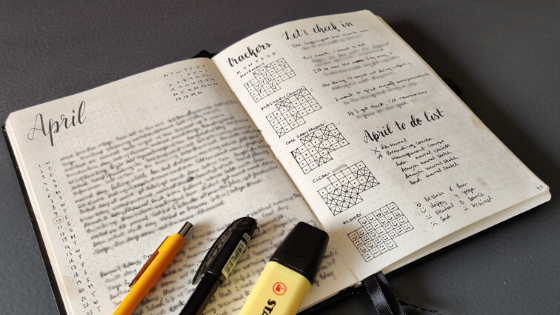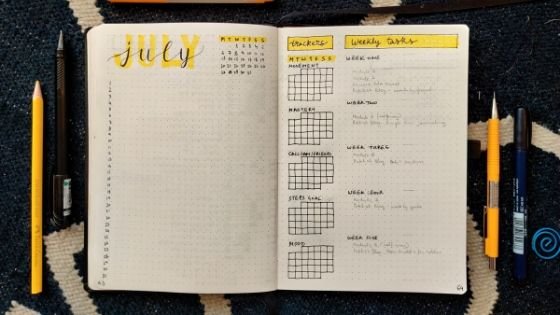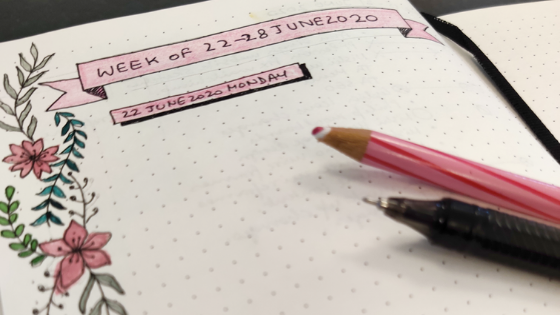I’ve always had a fascination for notebooks, stationery and lists. If there’s anything I can make a list for, I will. Need to go shopping at the mall? Make a list. Need to pack for a trip? Make a list. Need to follow a morning routine? Make a list. Need to throw a party? Make a list. Need to make a big decision in life? Make a list. I literally make a list for anything and everything that could possibly be put on a list.
Keeping a track of lists is not easy, and things can get quite overwhelming quickly if they get out of hand. It’s been my life long mission to find the perfect way for me to manage my lists and get shit done! And though I’ve experimented with various ways of doing that, things really fell into place for me when I discovered The Bullet Journal Method.
What is a bullet journal?
So what is a Bullet Journal and why is it so great? Yes, it’s a journal, but it’s also much more than that. It’s a flexible system for keeping you organised, and sane, therefore productive.
Before I dive into it however, I want to tell you to not be disillusioned by the beautiful spreads you see on social media when it comes to bullet journals. Just like real lives vs. social media lives, it’s not as perfect as it seems. You don’t have to have artistic skills or good handwriting to maintain a bullet journal. Your journal can be as beautiful or simple as you want it to be; because at the end of the day, YOU need to use it and it needs to work for YOU.
Flexible
As you read further, keep in mind that the bullet journal method is flexible. There are various components to it, however, at any point, you can customise it to work for you. If you want to switch things up and around, you can totally do that.
System
There is, however, some method to the madness and in order to break the rules, you need to know them. Understanding how the system works will only help you in customising it for yourself. So in this post, I’ll try my best to explain that system to you in as simple a manner as I possibly can without it being overwhelming. We’ll strip back from the pretty spreads and cover the basics.
Keep
The bullet journal will only work for you if you ‘keep’ it, it’s not a magic method that’ll work on its own. Think of it as pulling the strings to make a puppet move for you. You should try and dedicate at least 10-15 minutes or so every day for it to work. It can be in the morning when you’re planning your day or in the evening when you’re reflecting on it. When you feel like you need to get something done or when you just need to organise your thoughts.
Organised
For the Potterheads out there, think of it as a Pensieve you drop your thoughts in. Once you get it all out, the bullet journal method helps you organise all your thoughts, tasks, goals and whatnot. When you see it all in one place and put each ‘thought’ into its respective section, they start looking more manageable and that feeling that your brain is about to burst goes away and you’re able to address the things that are most important to you, breaking through the clutter.
Sane
Bullet journaling is a mindful practice, it encourages you to be intentional about everything that you put into it. Is this important to me? Do I really want to do this? How does it make me feel? What’ll start out as a journey to get organised, will quickly become a way for you to maintain your sanity and make sense of the world.
Anatomy of a bullet journal
So, now that I have sung so many praises of the bullet journaling method, let’s dive into it, shall we? Here I’ll break down the various components of a bullet journal and how they all work together.
Index
The index will be like your table of contents. All the pages in your journal need to be numbered. And with each section that you set up in your journal, you can enter in your index the name of the section and the corresponding page number. The purpose of this is to help you refer quickly to sections of your bullet journal so that you don’t waste time flipping through it looking for a specific thing.
Personally, I do number my pages and keep an index, but I only end up writing in it the ‘main’ section I set up, and hardly ever refer to it, because I use my journal often enough to know where everything is. Plus I have like five bookmarks in it to help me flip to regularly accessed sections quickly.
Future Log
The future log is where you set up the entire year to view at a glance. This is where you enter events that are to upcoming in the future, typically events like birthdays, anniversaries, upcoming holidays etc. Anything which is not happening in the current month.
I like to make the calendar in the future log as well, just so that I can take a look at the dates and days of the week they fall on while I plan.
Monthly Log
The monthly log is set up for the month that you are currently in. You’ll have all the days on the month on this page and when you’re setting it up, you refer to your future log and transfer all events over to your monthly log. This is also where you can set goals and tasks for that particular month and set up any habit trackers if you want.
I also like to use this space to write one line journal entries after the day has ended. This allows me to reflect back on what I did that day. Small cues like that help me remember what the month was like and if anything significant happened.
When you set up a new month, you’ll want to go over all the pending tasks of the previous month and ask yourself, is this important to me? Do I still want to do this? If yes, put it in the to-do list for the new month.
You can also set up habit trackers on the monthly spread to track any habits that you’d like to inculcate on a daily basis, this allows you to reflect at the end of the month how you’re doing, what days you perform well, how one habit correlates with another. For example, from tracking my mood, workouts and study sessions, I now know that Thursdays are my most productive days and the days I work out, my mood tends to be better.
Daily Log
The daily log is where your tasks for the day will sit, this is where you can also do rapid logging (more on that in a bit) and where the actual ‘bullets’ come in to play. The daily log is what you set up every day and help plan your day. At the end of the day, go over the entries in your daily log. You’ll want to cross off the things you’ve done or migrate certain tasks and notes (more on that in a bit too)
Some people like to set up a weekly log instead of a daily log. Personally I don’t like to do that because you never know how much space you will need for a particular day. Creating the daily log on the day or the day before works best for me.
Collections
You can build custom collections for tasks and notes that fall in a particular category. This is where the flexibility element comes in. You can make a collection for anything that you might want to keep track of, collect thoughts on, make lists about.
Some of the collections in my bullet journal are about the books I want to read, goals for the year, people I want to keep in touch with, places I want to visit, packing checklists, etc.
Where the bullets come in
Now that you have all your collections set up, let’s get to the actual bullet journaling bit of it. Yes, there is more, we’re not done yet, but once you get the whole thing, it won’t be that daunting. I promise, so don’t be lazy, read on.
What you need to set up next is your Key. The key defines what each entry in your bullet journal means, allowing you to interpret everything a lot faster.
Tasks
Usually denoted as a ‘•’ bullet point (therefore – Bullet Journaling) a task is, well, something you need to get done. Use a dot instead of a checkbox because it’s neater and you’ll need to either cross it off (X) when you’re done, or migrate it.
Events
Usually denoted with an ‘O’ (I prefer a triangle), Events are any entry that has a time or date related to it. This can either be something that you’ve scheduled, like an appointment or meeting or something that occurred and you want to make a note of it, like the day you met a goal or did something super significant.
Notes
Usually denoted with a ‘—’ symbol, it’s for anything that you might want to make a note of, such as a fact, feeling, thought or idea. Something that you don’t want to forget and might want to refer back to.
Signifiers
These are additional symbols you add next to the main bullet that adds more meaning to the entry. This is useful for when you are scanning a list and want to call special attention to a particular entry. For example, I might add a * for tasks that are high priority or the initials of team members I may have delegated a task to or a ‘?’ for tasks that I’m waiting to hear back on.
How it all works together
Now that you’re well versed in all the components that go into a bullet journal, let me explain how it all works together.
Rapid Logging
The idea is to log your thoughts and tasks as and when they come to you, using the bullets we’ve discussed above and then reflect on them.
Nesting
Just like you indent bullet points in a document, you can nest entries in your bullet journal. For example, I may have the main task such as ‘Plan a party’ with sub tasks nested under it such as ‘Order the cake’, ‘Send out invites’, ‘Prepare games’ under it. You can nest any type of bullet entry such as a note under an event or a task under a note.
Migration
At the end of the day, you may not have been able to complete all the tasks, however, each entry needs to be resolved in order to break through the clutter. Either a task needs to be completed, rescheduled, or cancelled. This helps make sure that you are focusing on what is important to you.
At the beginning of each day, look at the tasks from the previous day. What still needs to be done?
- If there is a task that’s incomplete which you can work on today, convert the dot into a forward arrow ‘→’ to and move the task to the current day.
- If the task needs to be rescheduled for another day in the future, convert the dot into a backward ‘←’ and flip back to your monthly log or future log and put the task in front of the respective date.
- If the task is no longer relevant, strike through it.
- If it’s a note that belongs in a collection, add a backward arrow and move the note to that collection.
Now all this may seem like a lot of work, but that’s the point, it makes you mindful of everything that you’re spending your time on. You get a chance to really reflect and think about whether this is important to you and whether you want to be spending your energy on this task, event or thought. It’s meant to ask you, is this worth the effort?
What you need to get started
You don’t need anything too fancy to get started. Just a notebook, a pen and the mindset.
Personally, I prefer a dot grid notebook, this is because I find that the page gives me the flexibility of a blank page, yet the structure of a lined or checked one. I can break the page up into sections, and work without the visual clutter of a lined notebook.
Making a bullet journal work for you
As mentioned before, the bullet journal method is highly flexible, you just need to know all the rules to break them. You don’t need to have great handwriting or artistic skills to do this, and you can use it for any aspect of your life that you want. Whether it’s to be productive at work, or organised with life admin stuff, to keep a record of the past or dream big for the future. You can spend hours in a day, drawing or writing, or just ten minutes jotting down the essentials. At the end of the day, you do what works for you.

















